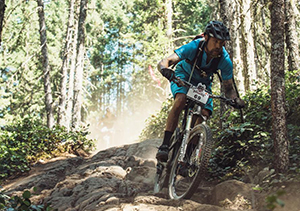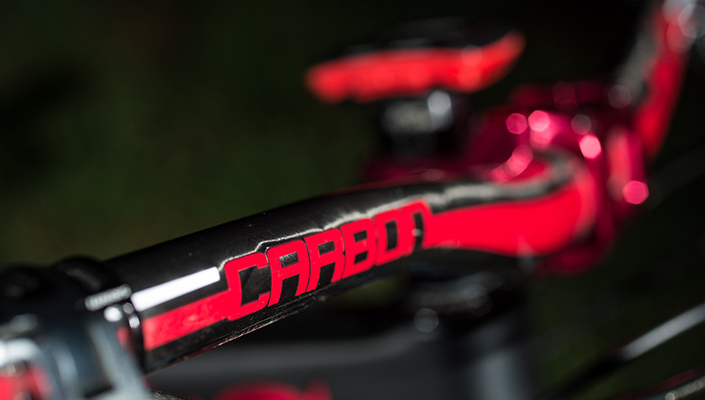Many people who have yet to ride with a carbon handlebar have argued that the marginal weight savings is not worth the price. With a going rate of $150 and up, it's easy to see why most people would dismiss carbon handlebars as an unnecessary upgrade from alloy. Once a disbeliever myself, it took a day of riding bike park with a Race Face SixC carbon bar to completely change my mind. Actually, all it took was half a run.
With your hands being one of three contact points between you and your bike, taking care of them is extremely important. Weight savings is but one of many benefits of running a carbon bar on your DH, AM, or XC bike. Here are the top 4 reasons to go out and buy a carbon bar for your mountain bike.
1. Hand comfort

image: freehubmag.com
Without a doubt this is the most important reason to run a carbon handlebar. Halfway through my first bike park lap on a carbon bar and I noticed the reduction of arm pump and claw grip.
I was in disbelief as I rode all day with dramatically decreased pain in my hands, wrists, and arms. This is a big deal for me as I have broken every finger and the side of my right hand. Carbon dampens energy - we know this from road bikes as this is the main motivation behind carbon forks and seat posts. Carbon is able to absorb more energy without reverberating it back to its source better than aluminum, thus reducing the vibration that tires your hands and arms.
When gripping your bars, you are, without realizing it, squeezing incredibly hard. Try squeezing your bars as hard as possible and focus on how it makes your hands feel. Any small vibration can increase the strain on the small ligaments in your knuckles and the tendons in your wrists. Running fatter, softer grips just increases the diameter of the bar you're gripping and actually increases the strain on your ligaments and tendons. A carbon bar can help solve this and that equals more and safer park laps, and when you are paying for a lift pass getting as many laps in as possible is key. Carbon bar = more laps for your money.
NOTE:
Arm pump is the pain you feel in your forearms and wrists from extended use of your arm muscles. It can last well after you ride and can be mistaken for carpal tunnel syndrome (CTS).
2. Safety
This is connected to hand comfort. If your hands are feeling strong then you have more grip, and if you have more grip then you can hold on when things get sketchy. DH bike hand grip is pretty obvious, but it was riding my XC bike that I really noticed the safety benefits.
After a gruelling 4-hour climb into the mountains I was toast, my hands were done, and it began pouring rain. Basic physics taught us all that whatever goes up, must come down, and after a 4 hour climb I had a long way to descend with little energy. Having a carbon bar allowed my hands and arms to retain some energy, especially when cold, for the hour long descent.

image: youtube.com
Aluminum gets cold, which can also stiffen your hands up, making it more difficult to react and hold on when things get difficult. Even reaching out for the brake levers in freezing rain can seem impossible for tired, worn out hands. One thing you learn when you ride in big mountains is that you need to save a healthy amount of energy for your descent, and the longer you climb, the longer your descent. Carbon bars allowed me to have stronger, more reliable grip, for the sketchy and rain soaked descent.
Likewise, in the bike park most crashes seem to happen when you say "just one more run." With your hands being pretty toasted by the end of the day, having carbon bars may help you stay stronger for that last run.
3. Durability
A common misconception about carbon handlebars is that they are fragile and any drop, scratch, or crash means your bars are done. This is not true. Manufactures like Race Face, Deity, Easton, and Chromag all use multi-layer wrapping techniques in their carbon products. The multiple layers (usually somewhere between 7-9) of carbon overlap each other and make for bars that are more reliable and safer than aluminum, but with the same impact resistance. You would have to compromise the majority of those carbon layers to get the carbon to fail. Working in a bike shop at the foot of a bike park, we would see dozens of aluminum bar failures and warranty issues and only a small handful of carbon failures.
Aluminum bars can come in different stiffnesses and strengths, but they are ultimately limited by their design. Lighter, stiffer aluminum is more prone to cracking and breaking, softer aluminum is more prone to bending, and both are harder on your hands. Long story short, if you get an extremely strong aluminum bar, you will pay for it in hand pain and arm pump.
As handlebars increased in widths, bar stem clamping area widths stayed somewhat stagnant. When bars started creeping past the 750mm mark to aid in controlling 29" wheels, the alloy ones began to break right at the contact points with the stem. To solve this, component manufactures increased the barrel diameter of bars to 35mm and widened the clamping area of the stems, adding strength and rigidity. This helped the breakage issue for some of the bars, but at a cost of weight and potential over stiffness. Carbon's strength greatly reduced the failure rate of bars in all categories.
4. Wheel Control

image: bikes.com
The first time I rode a 29er, it had narrow XC aluminum bars. I noticed immediately that I was turning a fraction of a second late and miss-judging roots, rocks, and drops. Two things come into play here: 1) larger wheels enter corners sooner than smaller wheels, meaning you have to react quicker, and 2) a larger wheel has increased leverage over your handlebars. Without getting too sciency, the easiest way to understand this is that if your wheel diameter (including your tire) is a lot bigger then the width of your handlebars, then you will feel like it's harder to stay in control of your wheels. When the going gets rough, small aluminum bars will require more grip strength to keep the wheel correct, and the more you grip the more fatigue you get in your hands and the more arm pump you feel. Most carbon bars, whether they are for DH, AM, or XC, are available in a multitude of widths, thus giving you the ability to keep those large wheels in check.
Conclusion:
I understand completely how someone might think carbon bars are an unnecessary and expensive upgrade, but after selling dozens of sets a season to people desperate to solve their arm pump problems, I had zero returns and nothing but praise.
People tried everything: thicker gloves, thicker and softer grips, different brake lever positions... with little to no reduction in arm pump and hand pain. Switching to a carbon bar is often the only real working solution. The benefits are not only limited to bike park riders, any passionate bike person who spends good time in the saddle quickly learns carbon is more comfortable. Even if you're out for a 6 hour XC ride or multi-day adventure ride, you will be grateful you switched to carbon.
![]() Check out the Comparison
Check out the Comparison
Compare 4 carbon handlebars from Race Face, Deity, Chromag and Easton

RELATED ARTICLE:
Best XC Full Suspension Bikes for $1500-$3000
Looking for a new entry to mid level full suspension bike?BikeRoar has you covered with 6 of the best bikes for... READ MORE

RELATED ARTICLE:
6 Best Mountain Bike Tires for 2016
losing your grip? or maybe you're just in the market for some new tires?BikeRoar gives you their definitive list of the best tires...READ MORE




